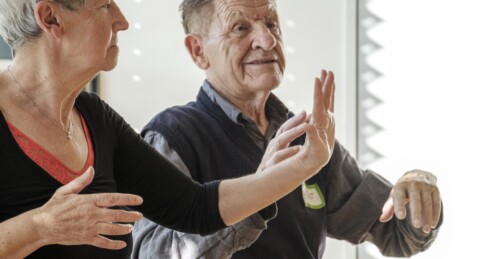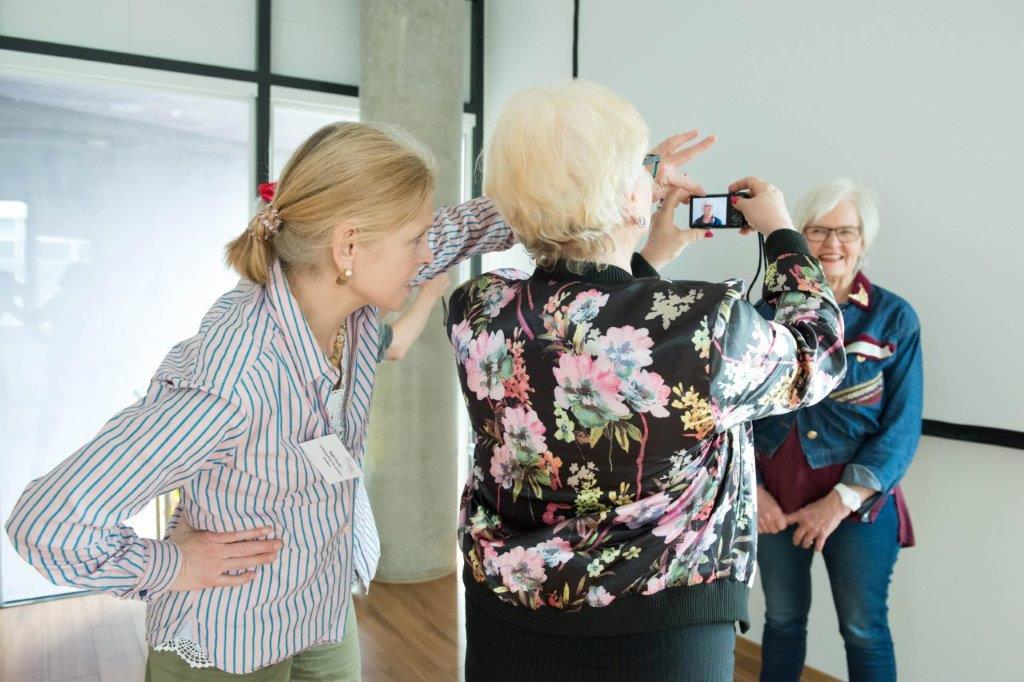
Cultural education in old age
This basic article explains what cultural education is and why it is also important in old age.

Anyone planning a cultural programme for older people is usually faced with the task of publicising it - and realises that this age group is so diverse that public relations work that appeals to everyone equally is not possible.
The term “age-friendly communication” goes back to the World Health Organisation (WHO). Since 2010, there has been a global network under its umbrella in which cities around the world have committed to creating an age-friendly local living environment. Incidentally, there are only three member cities in Germany: Münster, Stuttgart and Radevormwald.
With regard to “communication and information”, the WHO calls for older people to receive the information that concerns them in a timely, effective and easily accessible manner via the communication channels they are familiar with. In particular, the WHO emphasises the accessibility of information for older people with visual and/or hearing impairments.
Recognising the diversity of the target audience, the following outlines what is important if cultural and educational providers want to implement age-friendly communication in this sense.
There is no such thing as “the elderly” in the sense of a homogeneous group of people with similar characteristics, abilities and interests. Around 19 million people over the age of 65 live in Germany. Research sometimes draws the line at over 60 or even over 50, so we are talking about a span of around 40 years of life in which people are counted as “the elderly”.
Accordingly, the media usage behaviour of older people also varies greatly. In addition to physical and cognitive limitations, habits and preferences acquired over the course of a lifetime also play a role. The SIM study (“Senior*innen, Information, Medien”) from 2021 comes to the conclusion that there is “a large digital divide within the age group 60 years and older” (mpfs 2021, p. 17). For example, 83 per cent of the German-speaking people aged 60 and over surveyed have an internet connection. Almost as many own a computer, 72 per cent a smartphone. Almost two thirds use their smartphone once or several times a day. One in two use a computer at least once a day and almost one in three use a tablet. While the majority of this age group uses digital media and the internet frequently, a considerable proportion of older people do not use these devices or the internet at all.
According to the SIM study, 19 per cent of the population aged 60 and over are so-called “offliners”. However, there are major differences between the individual age segments: While only eight per cent of 60- to 69-year-olds and 18 per cent of 70- and 79-year-olds are offline, almost half of the over-80s are offline. In addition to age, other socio-demographic characteristics such as gender, household size, education and income also play a role.
According to the SIM study, two thirds of offline users are female and 61 per cent live alone. While only seven per cent of people aged 60 and over with a high school diploma or university degree do not use the internet, 27 per cent of people with a lower school qualification are offline. The situation is similar in terms of net household income: The lower the income, the higher the proportion of offline users.
This results in People of advanced age, especially if they are female, live alone, have a low income and a low level of formal education, reach cultural and educational providers primarily using analogue means of communication. Print materials such as flyers and brochures with a clear and accessible design can be used for this purpose, as can adverts or articles in newspapers and magazines. As many as 58 per cent of people over the age of 60 subscribe to a daily newspaper.
Conversely, this does not mean that digital means of communication are not just as important. After all, the vast majority of older people use the internet and the number of offline users is steadily decreasing. But which digital channels are particularly promising for reaching older online users? According to the SIM study, the most important online activity of people over 60 in Germany is research: four out of five older online users use a search engine at least once a week. In second place among the internet functions used at least once a week is communication via messenger services such as WhatsApp (75%), followed by email (70%). Older people therefore primarily use the internet to obtain information and communicate.
However, they are not very active on social media: only 21 per cent of all online users aged 60 and over use social networks at least weekly in 2021, a further six per cent rarely and 73 per cent not at all. The only network with significant use is Facebook. Instagram, on the other hand, which is also popular among the general population, is hardly used by people over 60. Promoting cultural programmes for older people on social media platforms is therefore only promising to a limited extent. However, practitioners report that very old people in particular often do not search for offers themselves, but are reached via people in their environment, such as younger relatives or carers, who can be successfully approached on social networks.
Probably the most important online communication tool for addressing older people is the classic website. This should be clear, well-structured and as accessible as possible. The website texts should also be easy to understand. This benefits all users, but especially older people, who are statistically more likely to be affected by visual and hearing impairments or declining cognitive abilities.
Measures that make it easier for people with visual impairments to use a website are particularly important. These include high contrast values, a large font, a clear page structure and large, clickable areas instead of small links in the text. Easy-to-find options for customising font size and contrast or having the text on a page read aloud can also be helpful.
Despite the diversity of lifestyles in old age, clichéd images of old age and old people are widespread in society. These include both negative ideas of old age characterised by illness, loneliness and reduced performance and positive ideas of ageing in wisdom and serenity, which exist side by side (see Kessler/Warner 2022, p. 58f.). Added to this is the image of “young-at-heart super seniors” often conveyed in the media and advertising (Kessler 2023, p. 11).
These are all stereotypes that have little to do with reality. Cultural education practitioners report the understandable reluctance of many older people to categorise themselves into a group based on their calendar age. As a result, they do not (want to) feel addressed when “senior citizens” are explicitly invited (cf. Skorupa 2018). Providers of cultural education programmes for older people should consider whether it is even necessary to explicitly state the age of the target group. Experience has shown that older people are happy to take part in age-open programmes if they are interested in the activity or topic. It is often enough to schedule an event on a working day during the day to limit the participants to people in the post-working phase.
In general, it is advisable to be aware of the individuality of people in later life and to reflect on your own images of age, not only in your public relations work, but also when designing your programmes, in order to avoid unintentionally reproducing age stereotypes.
Eva-Marie Kessler (2023): „Altern – ältere Menschen – demographischer Wandel“ in Sprache und Bild – ein Kommunikationsleitfaden. Ed. by Bundesministerium für Familie, Senioren, Frauen und Jugend. Berlin.
Eva-Marie Kessler, Lisa Marie Warner (2022): Ageismus. Altersbilder und Altersdiskriminierung in Deutschland. Ed. by Antidiskriminierungsstelle des Bundes. Berlin.
mpfs (Medienpädagogischer Forschungsverbund Südwest) (Ed.) (2021): SIM-Studie 2021. Senior*innen, Information, Medien. Basisuntersuchung zum Medienumgang von Personen ab 60 Jahren in Deutschland. Stuttgart.
Magdalena Skorupa (2018): Alter, was geht? Wie Kunst und Kultur unser(e) Selbst-Bild(ung) stärken und stereotype Altersbilder revidieren. In: Kulturräume+ 14/2018, pp. 26-28.
Yvonne Giedenbacher (2021): Neue Bilder des Alter(n)s. Wertschätzend über das Altern kommunizieren. Ed. by Dachverband der österreichischen Sozialversicherungen. Vienna.
Susann de Luca (2023): Ewig jung oder senil und vergreist? Vielseitige Altersbilder in den Medien gefragt. Ed. by Mitteldeutscher Rundfunk. Leipzig. (Access: 23.02.2024)
Anja Hartung et al. (Hrsg.) (2023): Seniorenmarketing. Medien & Altern. Zeitschrift für Forschung und Praxis. Heft 23. Munich.
The “Age-Positive Image Library” of the Centre for Ageing Better (UK) makes photos that depict older people in a positive and realistic way freely available.